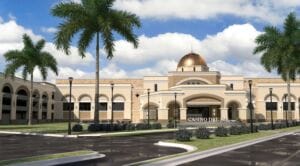Construction of healthcare facilities in Arizona boldly forged ahead in 2010, despite an economy that refuses to rebound and uncertainty over the impact of federal healthcare reform.
Officials figure that Arizona’s population will continue to grow and age, and because of the new federal law more people will have access to health insurance, which indicates a greater need for healthcare facilities.
Major players in the healthcare field from the Metro Phoenix area to outlying rural communities are investing in the future in a big way. Arizona healthcare facility projects with a total estimated cost of nearly $1B are finished, nearing completion or in the planning stage.
Banner Health has four projects totaling almost $300M: Banner Ironwood in Queen Creek, Banner Good Samaritan in Phoenix (expansion), and the Banner MD Anderson Cancer Center and Banner Gateway Medical Office II in Gilbert.
“You might say we’re in the business of being futurists,” says Peter Fine, president and CEO of Banner Health. “The risk of investments is not for the faint of heart.”
Technology a Driving Force in Healthcare Facilities
There is concern regarding healthcare reform that focuses mainly on how reimbursements will occur. Federal officials are pushing for more accountability in patient care outcomes, tying reimbursements to those efforts. As a result, information technology is becoming a key factor.
Mark Peterson of SmithGroup, a design and engineering firm, is working with clients to create healthcare facilities that play a direct role in patient care. It’s called evidence-based design.
“We’re providing clients with building solutions that support their patient-care mission and can be proven that there is a direct correlation between building design and improved patient outcomes,” Peterson says.
While the need for healthcare facilities most certainly is growing, some say the bad economy is resulting in a slight decrease in the utilization of hospitals. Experts say people are going to their doctor more and using hospitals less than they did a few years ago, especially those who have lost their jobs and may not have insurance coverage for an expensive hospital stay.
Another trend, experts say, is an industry focus on the word “healthy,” rather than the word “sick.”
“With a focus on healthy, what does this landscape look like?” queries MaryAnn Guera, CEO of BioAccel, a nonprofit organization that drives economic development through commercialization of late-stage basic and applied research in the life sciences. “Health or sickness? The look of the buildings we need will change around that.”
Metro, Rural Areas See Activity
Jason Meszaros, vice president of Irgens Development Partners, says healthcare projects in the Phoenix area represent the only type of development “that has any legs.”
Compared to previous years, construction has fallen off somewhat, some medical condos are back on the market, and there is still a desire for medical office space on or near medical campuses, he says.
For Irgens, which is building a 51,000 SF medical office facility in Gilbert, and for most others in the field, activity in 2011 should be fairly moderate, Meszaros says. Healthcare reform, the economy and population growth are all factors.
“The healthcare reform act throws a little bit of uncertainty into it,” he says. “People are a little apprehensive to make a long-term commitment.”
 Even so, there is no shortage of building activity in the healthcare field, not just in the metropolitan areas, but in rural parts of the state, as well. Money for these ongoing projects comes from various sources, including tax-exempt bonds, operating reserves, philanthropy and the federal government.
Even so, there is no shortage of building activity in the healthcare field, not just in the metropolitan areas, but in rural parts of the state, as well. Money for these ongoing projects comes from various sources, including tax-exempt bonds, operating reserves, philanthropy and the federal government.
For example, Phoenix Children’s Hospital embarked on a $588M expansion project in 2008, which will be 90% completed by the end of 2010. Officials expect to have the ambulatory clinics open by January, and hope to occupy the 11-story patient tower by June, increasing the number of beds to 626 from 345.
Bob Meyer, Phoenix Children’s Hospital CEO, says the project is funded primarily with $320M in tax-exempt bonds, plus operating reserves, fundraising and philanthropy.
There were 900,000 children in Maricopa County in 2003 when Phoenix Children’s began planning for expansion. That number has increased to 1M, and by 2030 as many as 1.7M kids will be living in the Phoenix Metro area.
“That’s why we’re building the building,” Meyer says.
At the same time, people are living longer. The population over 80 continues to grow almost exponentially, creating an increase in demand for medical services.
“That’s what has most people in the industry concerned,” Meyer says. “Hopefully there will be magic drugs, but in today’s technology it’s going to be a challenge.”
Nathan Anspach, senior vice president for medical economics at John C. Lincoln Health Network, expects capital budgets to see increasing pressure from information technology investment. Basically, that means less money for hospital construction and more money earmarked for IT improvements.
“IT investments are going to be required as part of the healthcare reform act, and that will impact capital construction,” Anspach says. “Healthcare systems are all looking at IT investments for electronic records and electronic measures like WiFi, and that’s going to cramp the construction budget.”
Recognizing the growing importance of IT, John C. Lincoln is building a $6M data center adjacent to its new administrative headquarters in the North Valley near I-17. The 4,000 SF building is expected to be completed in the first quarter of 2011. Susan Fuchs, media relations specialist, says the new facility will provide “a more secure environment for data management and electronic medical records.”
“It’s the wave of the future,” she says.
An Investment for Arizona’s Future
At St. Joseph’s Hospital and Medical Center, affiliated with Catholic Healthcare West, Bob Campbell, vice president for business development in Arizona, says, “We are looking at making investments in our whole continuum of services, everything from physicians’ offices, outpatient services, joint ventures, hospitals that we have, and health plans that we operate.”
Suzanne Pfister, vice president of external affairs, says CHW is moving toward partnerships, not solely construction projects. She mentions a joint venture with SimonMed, an outpatient medical imaging system.
“Under healthcare reform, we see more of a push toward preventative, lower-level healthcare, less expensive healthcare,” Pfister says. “What we’re looking at is — how can the right patient be in the right place? Maybe that’s not a hospital. Maybe it’s urgent care, or into family practice with an after-hours clinic.”
In partnership with United Surgical Partners, CHW is building an orthopedic surgery hospital at 40th St. just south of Loop 202. The 75,000 SF facility is expected to open next spring.
Other healthcare facilities in the planning stage include a 16,000 SF cardiac catheterization lab at Chandler Regional Medical Center, and a 145,000 SF expansion of the patient tower adding about 100 beds.
“Connecting the dots between construction and healthcare reform is really going to force hospitals to partner more with community physicians and outpatient options,” Pfister says.
Banner Good Samaritan Medical Center launched a $71M expansion of its surgical services department. When completed in 2012, there will be 20 state-of-the-art operating rooms, 76 preoperative and postoperative bays, a new waiting room with technology to keep families apprised during the surgery process, plus other amenities, according to Banner Good Samaritan CEO Larry Volkmar.
In outlying areas, construction is underway at what will be called Florence Hospital at Anthem northwest of Florence, says Gilbert Hospital CEO David Wagner. Completion of the 96,000 SF building, which will include an 18-bed correctional unit, is targeted for next summer.
Other rural projects include the 75,000 SF Marana Health Center for MHC Healthcare, slated for completion in March, and the $4.2M Superstition Mountain Mental Health Center in Apache Junction.
Meanwhile, USDA Rural Development, an arm of the federal Department of Agriculture, has committed $28.6M, including loans, for Arizona healthcare projects this fiscal year, says spokeswoman Dianna Jennings.
Other projects aided with federal funds are: the Pinal Hispanic Council Clinic in Coolidge, Copper Queen Rural Health Clinic in Palominas-Hereford, and the La Paz Regional Hospital in Parker.
Peterson says the economy is having an impact on the way people approach their own healthcare, and that’s having an impact on new hospital construction.
“Private sector clients are moving ahead with strategic plans for future master planning
and how best to position their organizations in urban areas,” Peterson says. “That’s true in Phoenix and Tucson and a little bit in Northern Arizona. It’s all about capturing the market and having the best possible response to healthcare reform and emerging changes to the economy.”
[stextbox id=”grey”]
www.smithgroup.com
www.irgensllc.com
www.rurdev.usda.gov/az/
[/stextbox]



